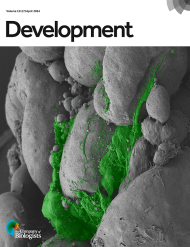Genetically-Modified Macrophages Accelerate Myelin Repair
Posted on: 15 November 2020 , updated on: 19 December 2022
Preprint posted on 28 October 2020
Article now published in EMBO Molecular Medicine at http://dx.doi.org/10.15252/emmm.202114759
Macrophages – the future pharmacists? Genetically engineered hematopoietic stem cells can act as drug deliverers to boost remyelination
Selected by Kristina KuhbandnerCategories: immunology, neuroscience
Updated 20 August 2022 with a postLight by Kristina Kuhbandner
Congratulations to Vanja Tepavčević and colleagues! Their preprint has been published in EMBO Molecular Medicine on July 13th 2022 (https://www.embopress.org/doi/epdf/10.15252/emmm.202114759).
The first author of the preprint – Vanja Tepavčević – is now last author of the peer-reviewed publication. In the published version, they complemented their study with additional experiments including a more in-depths characterization of oligodendrocytes recruited to the lesions and evidence that genetic modification of hematopoietic stem cells does not affect cell homing and maintenance in peripheral organs. This also answers one of the questions raised in the PreLight article. Furthermore, they show that increased OPC migration is mediated by the Sema3F-receptor Neuropilin 2, and that its expression is maintained on OPCs of middle-aged mice. All these points are critical for the translational feasibility and clinical relevance of the approach. Please take your time and check out how the reviewers’ comments have been addressed during peer-review: https://www.embopress.org/action/downloadSupplement?doi=10.15252/emmm.202114759&file=emmm202114759.reviewer_comments.pdf.
Overall, these additional experiments underline that genetic manipulation of blood cells is a promising therapeutic strategy to stimulate remyelination in Multiple Sclerosis patients.
Background
Myelin, produced by oligodendrocytes, is an essential component of the insulating sheath surrounding axons and ensures proper spread of nerve impulses1. In Multiple Sclerosis (MS), a chronic inflammatory disease of the central nervous system (CNS), the destruction of this myelin sheath by an autoimmune attack results in neuronal damage and loss, ultimately leading to typical clinical manifestations such as visual problems, fatigue and muscle weakness2. Although various immunomodulatory treatment options exist, so far it is not possible to completely stop progression or cure the disease. New strategies are focusing on enhancing myelin repair, which is critical to restore neurological function and prevent further axonal/neuronal damage1.
In some demyelinated regions in the CNS of MS patients, a loss of myelinating oligodendrocytes is observed. Since these glial cells derive from oligodendrocyte precursor cells (OPCs), the recruitment of OPCs to the affected areas is vital for myelin repair. The migration of OPCs is among others controlled by guidance molecules such as Semaphorin 3F (Sema3F)3.
A key feature of MS lesions, defined as white matter scars, is the infiltration of inflammatory cells, among others activated monocyte-derived macrophages. These are peripheral immune cells invading the CNS which play dual roles during the disease course. While they contribute to neuroinflammatory events and promote demyelination during the early disease stage, they trigger remyelination and alleviate disease in recovery phases4.
Recently, macrophages were used as drug delivery system in the context of tumor treatment5. The present study investigates whether myeloid lineage cells can also serve as vehicle for myelin repair-sustaining molecules under demyelinating conditions by transplanting genetically modified hematopoietic stem cells (HSCs) overexpressing Sema3F.
What was done?
The authors generated Sema3F-overexpressing HSCs by transduction with a lentiviral vector carrying the Sema3F- and GFP-transgene. Control cells were transduced with a vector only encoding for GFP. Vector functionality was confirmed in vitro among others by OPC migration assays using the supernatant of transduced HEK cells.
Subsequently, they genetically modified HSCs isolated from bone marrow of female mice by transduction with the validated lentiviral constructs. After in vitro expansion, the obtained cells were viable, retained their proliferation and differentiation potential, and secreted Sema3F.
Transplantation of these cells into male recipient mice resulted in a high reconstitution with donor cells eight weeks after retro-orbital injection. Of note, although GFP-Sema3F-transduced cells showed an increase in the generation of CD11b+ over CD19+ cells, general blood cell composition was not altered upon HSC treatment.
In the next step, they analyzed the impact of genetically engineered HSC transplantation on acute demyelination in the spinal cord. To induce focal lesions in recipient mice, they applied lysolecithin, a toxin eliciting a well characterized temporal pattern of de- and remyelination. GFP+ cells were detected in the lesions 7 and 10 days after lysolecithin treatment and numbers correlated with the percentage of GFP+ cells in the blood. Co-immunolabelling with the macrophage/microglial marker Iba1 showed that these cells were mostly of monocyte origin and further indicated that the general inflammatory response was similar in Sema3F-GFP HSC-transplanted mice and the GFP HSC control group. In the phase of maximal OPC repopulation, the number of OPCs and oligodendroglia was notably increased in Sema3F-GFP HSC-transplanted mice. Consistent with this enhanced OPC migration, significantly more newly generated oligodendrocytes were present in the lesions. Furthermore, regeneration of myelin was already observed at a very early time point of the remyelination stage.
Why I like this preprint
MS is a devastating disease affecting young individuals with a major impact on their daily life. To pave the way for a close to normal lifestyle, it is essential to develop new and safer strategies to stop the loss of neuronal function, for example by boosting remyelination. In my opinion, the concept chosen by Tepavčević et al. is very elegant and holds promising potential towards promoting myelin repair. It will be worth to investigate this approach in more depth in future studies. Importantly, besides MS, this strategy could also be used for the treatment of other demyelinating disorders.
Conclusion and future perspectives
Overall, these findings indicate that Sema3F-expressing blood-derived macrophages can attract OPCs to focal demyelinating lesions, thereby promoting oligodendrogenesis and myelin repair. However, to consolidate the efficiency and possible application as MS therapy, it will be key to validate these results in other models of demyelination such as the cuprizone model or experimental autoimmune encephalomyelitis; in particular as the complex immunological etiology of MS is not reflected in the lysolecithin model.
Questions to the authors
- Very few GFP+ cells seem to be present in the brain. Did genetically modified macrophages accumulate in peripheral organs?
- Do the authors have an explanation why SemaF3-GFP-transduced cells preferentially differentiate into CD11b+ compared to CD19+ cells?
- The used lysolecithin model is a model of acute demyelination lacking the presence of other immune cells at the lesion site. Do you expect comparable results in chronic demyelination? Will the presence of other immune cells influence the recruitment of genetically modified HSC to the lesions and their ability to attract OPCs?
- The increase in remyelination was already observed at a very early time point. Did you also determine myelin repair at later time points?
References
- Lubetzki, C., Zalc, B., Williams, A., Stadelmann, C. & Stankoff, B. Remyelination in multiple sclerosis: from basic science to clinical translation. The Lancet Neurology 19, 678–688 (2020).
- Thompson, A. J., Baranzini, S. E., Geurts, J., Hemmer, B. & Ciccarelli, O. Multiple sclerosis. The Lancet 391, 1622–1636 (2018).
- Piaton, G. et al. Class 3 semaphorins influence oligodendrocyte precursor recruitment and remyelination in adult central nervous system. Brain 134, 1156–1167 (2011).
- Wang, J. et al. Targeting Microglia and Macrophages: A Potential Treatment Strategy for Multiple Sclerosis. Front. Pharmacol. 10, (2019).
- Moyes, K. W. et al. Genetically Engineered Macrophages: A Potential Platform for Cancer Immunotherapy. Human Gene Therapy 28, 200–215 (2016).
doi: https://doi.org/10.1242/prelights.25725
Read preprintSign up to customise the site to your preferences and to receive alerts
Register hereAlso in the immunology category:
Control of Inflammatory Response by Tissue Microenvironment
Roberto Amadio
G6b-B antibody-based cis-acting platelet receptor inhibitors (CAPRIs) as a new family of anti-thrombotic therapeutics
Simon Cleary
Feedback loop regulation between viperin and viral hemorrhagic septicemia virus through competing protein degradation pathways
UofA IMB565 et al.
Also in the neuroscience category:
Sexually dimorphic role of diet and stress on behavior, energy metabolism, and the ventromedial hypothalamus
Jimeng Li
Enhancer-driven cell type comparison reveals similarities between the mammalian and bird pallium
Rodrigo Senovilla-Ganzo
Autism gene variants disrupt enteric neuron migration and cause gastrointestinal dysmotility
Rachel Mckeown
preLists in the immunology category:
Journal of Cell Science meeting ‘Imaging Cell Dynamics’
This preList highlights the preprints discussed at the JCS meeting 'Imaging Cell Dynamics'. The meeting was held from 14 - 17 May 2023 in Lisbon, Portugal and was organised by Erika Holzbaur, Jennifer Lippincott-Schwartz, Rob Parton and Michael Way.
| List by | Helen Zenner |
Fibroblasts
The advances in fibroblast biology preList explores the recent discoveries and preprints of the fibroblast world. Get ready to immerse yourself with this list created for fibroblasts aficionados and lovers, and beyond. Here, my goal is to include preprints of fibroblast biology, heterogeneity, fate, extracellular matrix, behavior, topography, single-cell atlases, spatial transcriptomics, and their matrix!
| List by | Osvaldo Contreras |
Single Cell Biology 2020
A list of preprints mentioned at the Wellcome Genome Campus Single Cell Biology 2020 meeting.
| List by | Alex Eve |
Autophagy
Preprints on autophagy and lysosomal degradation and its role in neurodegeneration and disease. Includes molecular mechanisms, upstream signalling and regulation as well as studies on pharmaceutical interventions to upregulate the process.
| List by | Sandra Malmgren Hill |
Antimicrobials: Discovery, clinical use, and development of resistance
Preprints that describe the discovery of new antimicrobials and any improvements made regarding their clinical use. Includes preprints that detail the factors affecting antimicrobial selection and the development of antimicrobial resistance.
| List by | Zhang-He Goh |
Zebrafish immunology
A compilation of cutting-edge research that uses the zebrafish as a model system to elucidate novel immunological mechanisms in health and disease.
| List by | Shikha Nayar |
Also in the neuroscience category:
‘In preprints’ from Development 2022-2023
A list of the preprints featured in Development's 'In preprints' articles between 2022-2023
| List by | Alex Eve, Katherine Brown |
CSHL 87th Symposium: Stem Cells
Preprints mentioned by speakers at the #CSHLsymp23
| List by | Alex Eve |
Journal of Cell Science meeting ‘Imaging Cell Dynamics’
This preList highlights the preprints discussed at the JCS meeting 'Imaging Cell Dynamics'. The meeting was held from 14 - 17 May 2023 in Lisbon, Portugal and was organised by Erika Holzbaur, Jennifer Lippincott-Schwartz, Rob Parton and Michael Way.
| List by | Helen Zenner |
FENS 2020
A collection of preprints presented during the virtual meeting of the Federation of European Neuroscience Societies (FENS) in 2020
| List by | Ana Dorrego-Rivas |
ASCB EMBO Annual Meeting 2019
A collection of preprints presented at the 2019 ASCB EMBO Meeting in Washington, DC (December 7-11)
| List by | Madhuja Samaddar et al. |
SDB 78th Annual Meeting 2019
A curation of the preprints presented at the SDB meeting in Boston, July 26-30 2019. The preList will be updated throughout the duration of the meeting.
| List by | Alex Eve |
Autophagy
Preprints on autophagy and lysosomal degradation and its role in neurodegeneration and disease. Includes molecular mechanisms, upstream signalling and regulation as well as studies on pharmaceutical interventions to upregulate the process.
| List by | Sandra Malmgren Hill |
Young Embryologist Network Conference 2019
Preprints presented at the Young Embryologist Network 2019 conference, 13 May, The Francis Crick Institute, London
| List by | Alex Eve |











 (No Ratings Yet)
(No Ratings Yet)